Back to Don's Maps
Mammoth engraving from Florida
Researchers from the Smithsonian Institution and the University of Florida have announced the discovery of a bone fragment, approximately 13 000 years old, at Vero, Florida with an incised image of a mammoth or mastodon. This engraving is the oldest known example of Ice Age art to depict a proboscidean (the order of animals with trunks) in the Americas. The bone was discovered in Vero Beach, Florida by James Kennedy, an avocational fossil hunter, who collected the bone and later while cleaning the bone, discovered the engraving. Recognising its potential importance, Kennedy contacted scientists at the University of Florida and the Smithsonian's Museum Conservation Institute and National Museum of Natural History.

The bone with the engraving is a long bone, possibly from a mastodon or mammoth.
Photo: Chip Clark / Smithsonian

22nd June 2011
Researchers from the Smithsonian Institution and the University of Florida have announced the discovery of a bone fragment, approximately
13 000 years old, in Florida with an incised image of a mammoth or mastodon. This engraving is the oldest known example of Ice Age art to depict a proboscidean (the order of animals with trunks) in the Americas. The team's research is published online in the Journal of Archaeological Science.
Photo: Chip Clark / Smithsonian

The bone was discovered in Vero Beach, Florida by James Kennedy, an avocational fossil hunter, who collected the bone and later while cleaning the bone, discovered the engraving.
Photo: http://www.palmbeachpost.com/
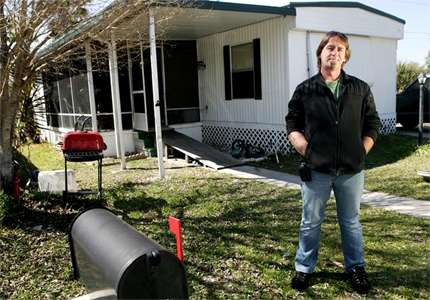
Recognising its potential importance, Kennedy contacted scientists at the University of Florida and the Smithsonian's Museum Conservation Institute and National Museum of Natural History.
Photo: http://www.palmbeachpost.com/
But scientists fear the rare artifact may be lost to public view forever. Kennedy plans to sell it at an auction, much like any private art collector might sell a Picasso, instead of giving it to a museum. The auction, which hasn't been scheduled, is being advertised online.Text quoted above from http://www.palmbeachpost.com/
Kennedy, who says he has severe epilepsy and mainly relies on Social Security checks to get by, is unapologetic about the sale.
"That's like having the lottery ticket and someone walks up and says, 'You should donate it,'" Kennedy said. "Well, no. You would say, 'No.'"
Kennedy said he found the artifact on private property, with the owner's permission, within walking distance of Vero Beach's "Vero Man" site along a canal south of the city's airport.
"This is an incredibly exciting discovery," said Dennis Stanford, anthropologist at the Smithsonian's National Museum of Natural History and co-author of this research. "There are hundreds of depictions of proboscideans on cave walls and carved into bones in Europe, but none from America—until now."
The engraving is 3 inches (75 mm) long from the top of the head to the tip of the tail, and 1.75 inches (45 mm) tall from the top of the head to the bottom of the right foreleg. The fossil bone is a fragment from a long bone of a large mammal — most likely either a mammoth or mastodon, or less likely a giant sloth. A precise identification was not possible because of the bone's fragmented condition and lack of diagnostic features.
"The results of this investigation are an excellent example of the value of interdisciplinary research and cooperation among scientists," said Barbara Purdy, professor emerita of anthropology at the University of Florida and lead author of the team's research. "There was considerable scepticism expressed about the authenticity of the incising on the bone until it was examined exhaustively by archaeologists, paleontologists, forensic anthropologists, materials science engineers and artists."
One of the main goals for the research team was to investigate the timing of the engraving — was it ancient or was it recently engraved to mimic an example of prehistoric art? It was originally found near a location, known as the Old Vero Site, where human bones were found side-by-side with the bones of extinct Ice Age animals in an excavation from 1913 to 1916. The team examined the elemental composition of the engraved bone and others from the Old Vero Site. They also used optical and electron microscopy, which showed no discontinuity in coloration between the carved grooves and the surrounding material. This indicated that both surfaces aged simultaneously and that the edges of the carving were worn and showed no signs of being carved recently or that the grooves were made with metal tools.
Believed to be genuine, this rare specimen provides evidence that people living in the Americas during the last Ice Age created artistic images of the animals they hunted. The engraving is at least 13 000 years old as this is the date for the last appearance of these animals in eastern North America, and more recent Pre-Columbian people would not have seen a mammoth or mastodon to draw.
The team's research also further validates the findings of geologist Elias Howard Sellards at the Old Vero Site in the early 20th Century. His claims that people were in North America and hunted animals at Vero Beach during the last Ice Age have been disputed over the past 95 years.
A cast of the carved fossil bone is now part of an exhibit of Florida Mammoth and Mastodons at the Florida Museum of Natural History in Gainesville.
Source: http://smithsonianscience.org/2011/06/bone-fragment-may-contain-only-known-ice-age-artwork-from-america-to-depict-a-proboscidean/
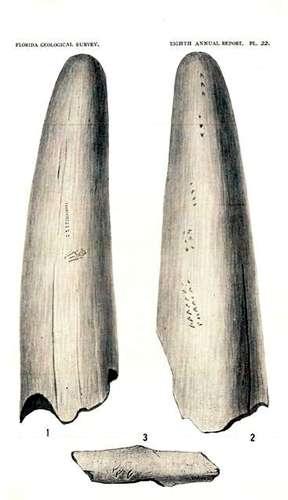
Two different views of one tusk (1-2) and bird bone (3) with man made engravings
Uncovered near the Old Vero Man Site by Dr Sellards.
Source: Florida Geological Survey 1916, Eighth Annual Report by Dr Sellards - Plate 22)
From: www.rennickauctions.com/Vero-Man-article.html
The following article helped bring to light an all but forgotten story about an amazing archaeological discovery that took place in Vero Beach, Florida in 1915. Later known as the Vero Man, the find provided the first anthropological evidence that human beings had inhabited the New World prior to the end of the Ice Age. Although the discovery attracted widespread attention and stirred considerable controversy among the scientific community, over the years the story gradually faded in memory. It remains shrouded in mystery.
"How Vero Man Was Found — And Lost Again" first appeared in the September/October 1998 issue of the Vero Beach Magazine. For his efforts in authoring the piece, Glenn received the Florida Magazine Association's 1999 Bronze Award for Excellence in Writing. The article continues to generate nation-wide attention.
How Vero Man Was Found — And Lost Again
It was just another day in the sleepy little town of Vero, Florida. Nothing much really ever seemed to happen here. Neatly nestled by the ocean and amongst its orange trees and pineapple groves, life went on in its usual, simple way. The sun had just begun to break through the clouds as Frank Ayers walked along the banks of the large drainage canal that ran alongside the north side of town. Frank had walked this same route almost every day, rain or shine, ever since friend C. Gifford, (one of the town's pioneers) had found some unusual fossils along these same banks some two years before.
A farmer and entrepreneur, Frank had developed quite a local reputation as a naturalist and often spent long hours with his close friend, Isaac Weills, a retired businessman from Harrisburg, Pennsylvania, in pursuit of their common fascination with natural history. On this day, however, Frank was alone.
Suddenly, he noticed something protruding from the canal bank. As he bent down to look more closely at what had caught his eye, something distinctive began to emerge. Anxiously, yet carefully, he began to brush the dirt from what was now recognizable as a human skull. Little did Frank know that he had stumbled upon a remarkable anthropological discovery and one that would eventually help to force a dramatic change in the thinking of Western scholars -- the discovery of the Vero Man.
As his excitement grew, Frank thought of Isaac, who had spent so many long hours walking the canal banks with him. Choosing to share his excitement with his friend, Frank hurried off to tell him about the find. A short while later they returned to the spot and as they continued to dig, found additional bones of apparently human origin. Several odd looking animal skeletons, the likes of which neither man had ever seen before, began appearing. Speculating that perhaps they had come across something of ancient origin, Frank and Isaac decided to contact the state geologist in Tallahassee, Elias Sellards.
Sellards came to Vero and immediately began an extensive and thorough excavation of the site. Over the next several months numerous artifacts and fossils were extracted. What made the discovery of Vero Man (as it soon became known) so remarkable to Sellards was that the human remains were found alongside several species of both plants and animals that had long been extinct. In fact, there were skeletons of birds, tapirs, elephants, and even camels that had not existed since the Ice Age.
To understand the implications of such a discovery, it is necessary to step back and try to understand the thinking at that time. In the early part of the 20th century it was the accepted opinion of Western anthropologists that human habitation in the New World did not extend further back than four thousand years. On this point there was strong consensus and little debate was ever offered. How this position had come about is quite interesting and integral to the controversy that Vero Man would ignite.
Ever since the discovery by Europeans of an advanced indigenous civilization in the New World, Western scholarship immediately set out to disprove any possibility that these cultures had evolved on their own. Fanciful myths were concocted to preclude any chance that a darker skinned people could have independently achieved such a high level of science and technology.
One popular theory that emerged soon after the Spanish Conquest was that the ancient Maya were descendants of the Lost Tribe of Israel. Still another claimed that they were a fringe settlement of a vast Phoenician culture. The list went on. This was nothing new, however. The rediscovery of ancient Egypt, and the disclosure of a powerful Negro-African element in the ancestry of a civilization to which Europe owed so much, came as an embarrassment. It had also come at an inopportune time. As millions of black slaves were being transported across the Atlantic, this new revelation threatened to explode the myth of white superiority necessary for the peace of the Western conscience.
One necessary ingredient essential to disallowing the Native Americans credit for their own achievements centered around the length of time they had been living in the New World. If it were generally accepted that their migration from Asia to the Americas had occurred in relatively recent times, few would dare challenge the notion that outside influences were primarily responsible for the pre-Columbian civilizations of Central and South America. There simply would not have been enough time for a native civilization to evolve by its own resources. By the 20th century it had been generations since Native Americans were burned at the stake for failing to accept Jesus. The slave trade had also been conveniently forgotten.
Nevertheless, there remained a rigid Eurocentric bias in Western thought. Nowhere was this more visible than in the study of the Native American peoples. The discovery by Frank Ayers of a human skull in Vero, Florida threatened to change this way of thinking once and for all. In July of the following year ( 1916), Sellards issued his report and a whirlwind of controversy began. In the report, Sellards convincingly concluded that Vero Man was contemporaneous with the extinct Ice Age era species of plants and animals found alongside him. How could this be if human beings had only existed in the New World for not more than four thousand years? To support his thesis, Sellards relied heavily on the geological evidence that the various fossil remains had been found within what was referred to as the Melbourne Formation. The Melbourne Formation is a stratum of earth found throughout Florida consisting of marl and limestone and dates to the Pleistocene period (Ice Age).
In response to the furore raised by Sellard's report, a team of scientists converged in Vero in October of the same year. The list of those included sounded like a Who's Who of America's leading geologists and anthropologists. Yale University, Johns Hopkins, the University of Chicago, the Carnegie Institution, and the Smithsonian were all represented, but there was far from any agreement. The geologists sided with Sellards and argued that the Melbourne Stratum in which Vero Man was located showed no signs of intrusion. In other words, there was no evidence that the skull of Vero Man had been washed into the site at a later date.
Heading up the other end of the argument was a Czech-born physical anthropologist from the Smithsonian Institution, Ales Hrdlicka. In 1907, Hrdlicka authored Skeletal Remains Suggesting or Attributed to Early Man In North America and aggressively discouraged any possibility that humans had settled in the Americas any earlier than four thousand years ago. Few scholars dared challenge Hrdlicka's unshakeable position and the recent arrival theory remained dogma.
The science of anthropology was in its infancy as a professional discipline. Consequently, Hrdlicka, like most physical anthropologists of his day, gave considerable importance to skull measurements as a means of dating skeletal material. The ratio between the front-to-back and side-to-side diameters (cephalic index) was believed to be an important dating tool. This method is no longer considered very important. Height, the cephalic index, and all the other related body measurements, are now believed to depend more on lifestyle and environmental conditions than evolutionary age. Nevertheless, as a result of the cephalic measurements taken of the skull, Hrdlicka was convinced that Vero Man was a modern Indian and could not have been a contemporary of the Ice Age animals whose bones surrounded him at the Vero location. (The discovery was made alongside the main canal just a few yards west of US 1 .) Dismissing the geological evidence entirely, Hrdlicka argued that Vero Man had simply been buried in the Melbourne Formation at a later time and his report in 1918 stated:
"The only conclusions concerning the Vero bones that the writer can arrive at, after a painstaking study of the locality and the specimens and after having given due consideration to the opinions of others, are that they are remains of modern Indian type..."
A few years later, in 1922, F.B. Loomis, Professor of Paleontology at Amherst College, investigated a similar find in Melbourne, Florida and visited the Vero site as well. Loomis made a presentation to the Paleontological Society of America and argued persuasively for an early dating of the skulls. Among those present was Ales Hrdlicka, who adamantly dismissed any such possibility. The meeting ended in disagreement. Hrdlicka was particularly unyielding, insisting right up until his death in 1943 that it was the measurable features of human bones, rather than geological evidence, that were the real clues to the antiquity of the first Americans.
The Great Depression ushered in public works projects all over the United States that unearthed numerous sets of human remains and artifacts which appeared to be pre-lce Age in origin. Needless to say, Hrdlicka remained steadfast. The new discoveries, however, generated further interest in the Vero Man. But just as answers appeared to be forthcoming, the tale of the mysterious skull was about to take yet another unexpected turn.
While Vero Man had always remained the property of the Florida Geological Survey and spent most of its time at the state museum in Tallahassee, by the late 1930's the bones had been in the possession of the Smithsonian's Department of Paleontology and Department of Anthropology as well. The publicity created by the discovery had literally put Vero Beach (as it was known after 1925) on the map. In the 1920's the city created Tarzan Park just a short distance from the site to commemorate the find. Tourist guidebooks of the period mention Tarzan Park and Vero Man before anything else in regards to the town. Interestingly, Sellards was so impressed with the area and its potential for additional findings that he decided to relocate to the community.
In the 1940s an attempt was made to make a cast of the skull at the state museum. Unfortunately, the skull suffered considerable damage as a result. lt was then sent back to the Smithsonian where yet another attempt was made to make a cast. According to Smithsonian documents, the skull was in such poor condition that accurate measurements were no longer possible and the bones were returned to Florida.
In 1949, radiocarbon dating was invented and it appeared that perhaps the mystery of Vero Man could be solved once and for all. Vero Man, however, could not be located. As more and more confirmed prehistoric human remains were discovered across the country, including several in Florida, there was waning interest in the skull from Vero. Despite being so important to the eventual acceptance of an early arrival date for the Native Americans, the memory of Vero Man gradually became as lost as his bones.
The story does not end here. In 1996, Pam Hall, the Indian River County Library's Florida History and Geology librarian, and Vera Zimmerman, an anthropologist from Brevard County, obtained a $10,000 grant from the Florida Humanities Council to organize a five week historical presentation on the early history of the area. Hall and Zimmerman saw to it that Vero Man would be an important part of the presentation and set out to find everything they could about him. Painstakingly, they compiled an archive of materials which proved invaluable to the researching of this article. Not only was the exhibit at the library a great success, but Hall eventually travelled to the Smithsonian, as well as the state museum, in a determined, but futile effort to locate the skull. Whether the bones were stolen, misplaced, or simply discarded due to their poor condition, may never be known.
Whether the bones of Vero Man are rediscovered or not, however, is secondary to their significance. Today it is a known fact that human beings lived in the Americas during prehistoric times - at least 15 000 years ago and most likely earlier. More importantly, the magnificent civilizations of the Inca and Maya are conceded to have evolved on their own. While there is some evidence that contact with other cultures prior to the arrival of the Spanish might well have taken place, scholars generally agree that any such contact was limited and had little to do with influencing the Mayan and Incan civilizations. That Native American peoples now look with pride upon the accomplishments of their ancestors, in large part dates back to one sunny day in Vero Beach when Frank Ayers decided to have another look and found the Vero Man.

Human ulna from Vero, found in stratum 3.
Photographed in February of 1916.
Source: Florida Memory - State Library and Archives of Florida
Search florida memory archive :
http://www.floridamemory.com/PhotographicCollection/
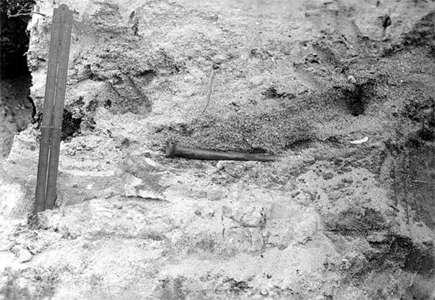
Human radius in position in the canal bank, Vero, Florida
Source: Florida Memory - State Library and Archives of Florida
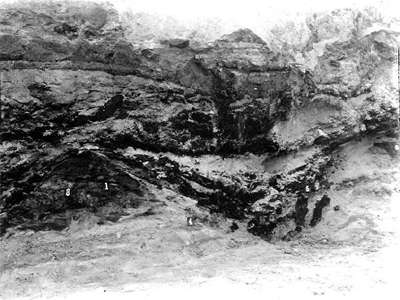
Close-up of stratum no. 2 at Vero where human remains were found in the canal bank, Vero, Florida
Photographer Sellards, Elias Howard
Source: Florida Memory - State Library and Archives of Florida
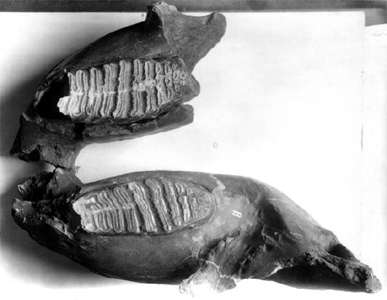
Elephas columbi, now renamed Mammuthus columbi, the Columbian Mammoth
Lower jaws of the Columbian Mammoth from Vero.
Source: Florida Memory - State Library and Archives of Florida
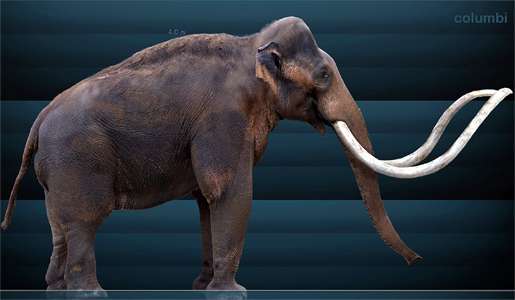
The Columbian Mammoth, Mammuthus columbi, was one of the largest of the mammoth species and also one of the largest elephants to have ever lived, measuring 4 metres (13 ft) tall and weighing up to 10 000 kilograms. It was 10.7 feet (3.3 m) long at the shoulder, and had a head that accounted for 12 to 25 percent of its body weight. It had impressive, spiralled tusks which typically extended to 6.5 feet (2.0 m). A pair of Columbian Mammoth tusks discovered in central Texas was the largest ever found for any member of the elephant family: 16 feet (4.9 m) long.
It was a herbivore, with a diet consisting of varied plant life ranging from grasses to conifers. It is also theorised that the Columbian Mammoth ate the giant fruits of North America such as the Osage orange, Kentucky coffee and Honey locust as there was no other large herbivore in North America then that could eat these fruits.
Using studies of African elephants, it has been estimated that a large male would have eaten approximately 700 pounds (320 kg) of plant material daily. The average Columbian mammoth ate 300 pounds of vegetation a day.
Text: Adapted from Wikipedia
Photo: Sergiodlarosa
Date: 2008-11-05
Permission: GNU Free Documentation License
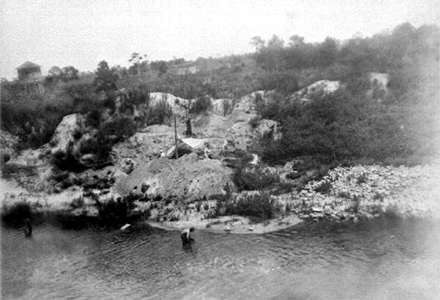
Vero Canal site, showing where excavation for human remains was made.
Photo: Sellards
Source: Florida Memory - State Library and Archives of Florida
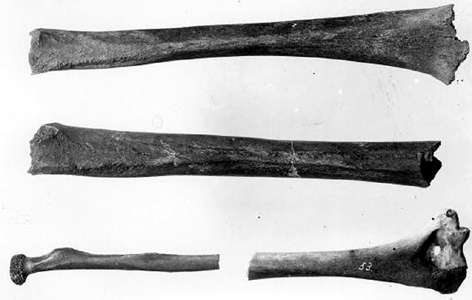
Vero human remains
Source: Florida Memory - State Library and Archives of Florida
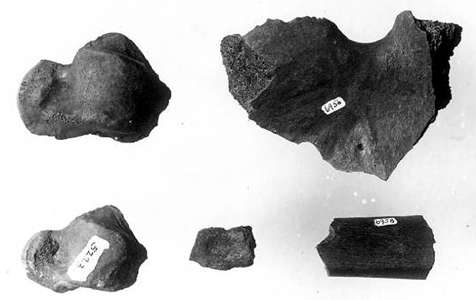
Vero human remains
Source: Florida Memory - State Library and Archives of Florida
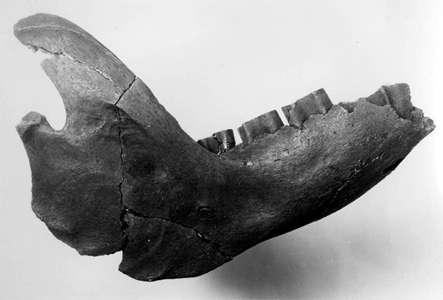
Jaw of Chlamytherium, an extinct giant armadillo, Vero.
Source: Florida Memory - State Library and Archives of Florida
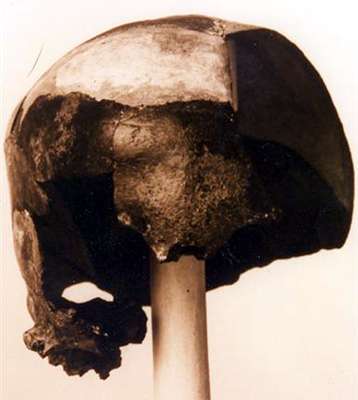
Cast from original human skull fragments found in place with mega-fauna fossils at the "Vero Man Site".
Source: Photo taken by Vera Zimmerman (1996) at the Smithsonian Institution Paleontology Archives in Washington D.C.
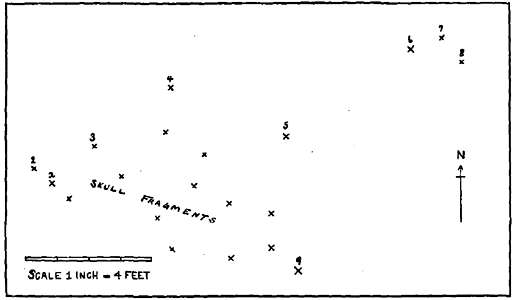
Ground plan showing the location of human bones found in the canal bank at Vero in April and in June, 1916.
Index to bones:
1 Left ulna
2 a part of the shaft of the same bone
3 left femur
9 a part of the shaft of the same bone
4 radius
5 metatarsal
6 astralagus
7 external cuneiform
8 part of ilium
Photo: Sellards (1917)

Photograph showing the ulna, femur and radius in place in the bank.
Photo: Sellards (1917)
References
- Sellards E., 1917: Further notes on human remains from Vero, Florida American Anthropologist N.S., 19, 1917